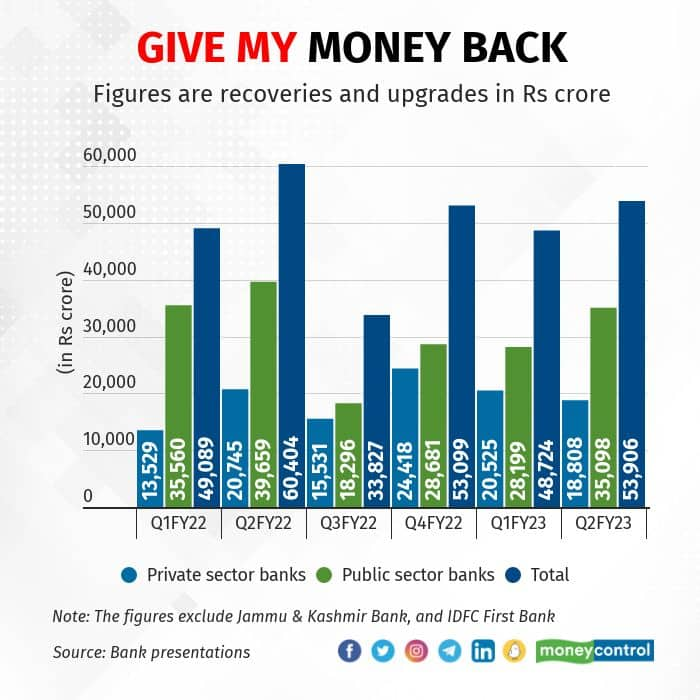



India’s banks are enjoying perhaps the best attention from investors and analysts with their earnings outlook outshining other sectors. Two public sector banks–State Bank of India and Bank of Baroda–seem to have sprinkled stardust over the sector.
The Nifty Bank index has outpaced the broader Nifty50 by a mile, notching up a 13 percent gain on a year-to-date basis against the benchmark’s modest 2 percent rise. Analysts have jacked up the target prices of most bank shares.
While it seems counterintuitive to question the optimism on the asset quality of banks, a little caution hurts no one. Parsing the bad loan numbers reveals some niggling doubts on asset quality.
Also, as Kotak analysts put it in a recent note, “While bank managements have reported not witnessing any macroeconomic deterioration on the ground, it continues to be an overhang for investors.”

Dark corners amid sun rise
The gross bad loan pile of 30 listed banks shrank by about Rs 1.18 lakh crore year-on-year for the September quarter, according to calculations by Moneycontrol. After this 15 percent fall, the amount stands at Rs 6.62 lakh crore.
Public sector banks reported the sharpest fall in bad loans at Rs 91,000 crore. The 18 listed private sector banks reported an aggregate fall of about Rs 27,000 crore.
Corporate deleveraging, insolvency procedures and a recovery in economic growth have helped to almost halve the toxic asset pile of banks.
But mere headline numbers do not tell the complete story. What is interesting is how banks have brought down their dud loans. Recovery and upgrades are down roughly 10 percent year-on-year for listed banks at the aggregate level, Moneycontrol calculations show.

On the other hand, write-offs are up 22 percent from a year ago and 68 percent sequentially. A large part of the fall in gross bad loans is simply due to loans kicked out of the balance sheet on the view that recovery is not possible.
Though the end result is a cleaner balance sheet, this does not lend conviction about the ability of banks to price credit risk appropriately. SBI’s research wing recently pointed out that risk pricing isn’t adequate even now.
“For example, short-tenor working capital loans of less than 1 year are given even with finer rates at lower than 6 percent linking with 1M/3M T Bill rates. 10-year and 15-year loans are being priced at less than 7 percent. It is to be noted that 10-year G Sec is currently trading around 7.46 percent, while 91-day T Bill at around 6.44 percent and 364-day T Bill at around 6.97 percent,” it said in a November 7 report.
Are the seeds of the next bad loan pile-up being sown?
Death by a thousand cuts
The previous bad loan cycle was manifested by large corporate loans that quickly decimated the capital of banks. However, loans to small businesses have been a consistent pain point.
Delinquency rates in loans to micro, small and medium enterprises (MSMEs) have been elevated and in double-digits. The slow bleeding of income from such loans seldom comes to light, given the rather limited impact on headline non-performing asset (NPA) metrics.
Over the past two to three years, public sector banks have had 17-20 percent of their MSME loans turn bad. Despite pandemic-related relief measures from the government, the stress has hardly eased.
Greater formalisation due to tax reforms continues to hurt informal small businesses. It is important for lenders and their investors to keep a weather eye on this segment.
Who is a good boy?
Lending is a risky business and to that extent there will always be bad assets on a bank’s balance sheet, even in good times. But some lenders are more adept than others at managing the bad times.
That brings us to the important exercise of differentiating between lenders. Within the public sector, Punjab National Bank, Bank of India and Central Bank of India do not inspire investor confidence.
PNB’s bad loans fell 13 percent year-on-year but its write-offs remained elevated at Rs 2,614 crore. Smaller lenders such as UCO Bank, Punjab & Sind Bank and Indian Overseas Bank still have fragile balance sheets.
The spectre of lending pushed by government compulsions remains. Peers in the private sector are better off, but some are still battling headwinds. Write-offs have increased for most private sector lenders on a year-on-year comparison.
Fresh slippages have increased sequentially for lenders, indicating that stress has built up.
“There isn’t much to rejoice beyond SBI in the public sector because the structural factors are still the same. You have to participate in government schemes and these banks are yet to prove that their risk management has gotten better,” said an analyst with a foreign brokerage, requesting anonymity.
The fact that most public sector bank shares still trade at a discount to their book value shows that the market is being cautious. The same goes for select private sector banks, too.
Discover the latest Business News, Sensex, and Nifty updates. Obtain Personal Finance insights, tax queries, and expert opinions on Moneycontrol or download the Moneycontrol App to stay updated!
Find the best of Al News in one place, specially curated for you every weekend.
Stay on top of the latest tech trends and biggest startup news.